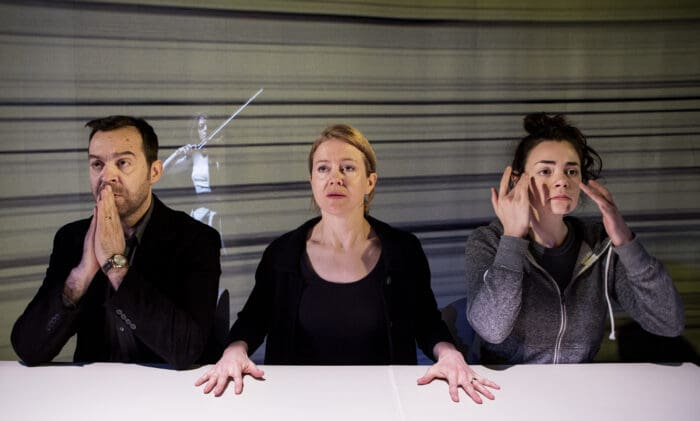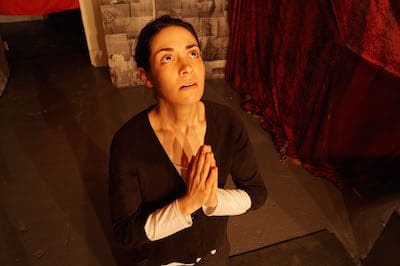
With the weather warming up and city-dwellers coming out of hibernation, the Toronto theatre community is providing plenty of places for them to go. You could head down Yonge Street to see Once (starring the always likeable Ian Lake) or to The Annex for The LOT’s Hairspray (with the amazing Matt McKay as Seaweed) then turn left and walk a few blocks for some Bad Dog improv action or to catch the final few performances of Nature of the Beast at the Storefront. If you go East, CanStage has Spotlight South Africa (we have special guest coverage with six reviews coming soon!) then, in the Distillery District, George Brown Theatre School is sending off their 2015 graduates with Peer Gynt (Matthew Finlan is particularly great in the lead role) and Anna Karenina in rep while the fantastic Soulpepper Concert Series closes out The Nina Project and launches into The Big Easy.
The Mid-West section of the city (University-Ossington), in particular, has always been a hot spot for theatre and there’s a ton going on there right now. The following are just a few examples:
Tarragon/Volcano’s Infinity (Dupont & Bathurst)
The latest one-act from Tarragon regular Hannah Moscovitch is intellectually ambitious and emotionally engaging but a far cry from the playwright’s best work. A fairly standard though excellently performed domestic drama, Infinity wraps its relatable mundanity in an intriguing and under-explored contemplation of genius and its consequences, rhapsodizing on science like so many contemporary plays do (artists’ fascination with scientists must have something to do with how alien they seem in a right-brain/left-brain sense) but always bringing the theorizing back to the personal, where Moscovitch is most comfortable. Anchored by a breathtakingly empathetic performance from Paul Braunstein as a physicist whose study of time pulls him out of his life, Infinity is a few too many good things that add up to one big just fine thing.

Headstrong Collective’s Boston Marriage (Queen & University)
A challenging text meets a trio of splendid (though awkwardly costumed) actresses who make wonderful connections in this thoroughly enjoyable production of a lesser-known Mamet play. The script’s fascinating anachronism is not mined thoroughly enough and the production drags early in act two when Charlotte Dennis’ scene-stealing maid Catherine disappears while dull scheming overtakes the riveting emotion and biting wit that characterizes the rest of the play, but the scintillating chemistry between Catherine McNally and Deborah Drakeford is enough to pull you through until the pace picks back up. From an artistic point of view, this easily maintains Headstrong Collective’s amazing .1000 batting average but, from a practical point of view, it’s a little confusing. These are big performers (in both prestige and performance style) and a big text trapped in a tiny room with a small, cramped audience. Though the allure of no-money, no-effort set decoration is understandable, Campbell House should really be reserved for site-specific works that are going to move around and really use the space. I like Campbell House, but this show needs a theatre.

Soup Can’s Heretic (King & Bathurst)
Sarah Thorpe is a pretty remarkable theatre-maker. Her work ranges from excellent to severely wanting- and Heretic is merely somewhere in the middle of that scale- but the sheer size of her ambition and drive, year after year, is consistently impressive. The founding artistic director of the reliably productive Soup Can Theatre, Thorpe is refreshingly unafraid of making her own opportunities- in this case, the opportunity to play a legendary figure and carry a challenging production on her own. The trouble with such a self-started project is that the creator/performer didn’t have a strong enough outside eye to help her with details like smooth character transitions and big-picture issues like commitment to a period vs. universality. It’s a confounding flaw considering the program lists a director and TWO assistant directors- one of whom doubled as a dramaturge- and makes the solo show feel a little too solo (though it should be noted that scenographer Claire Hill’s history-of-Joan collage and sound designer Jakob Ehman’s climactic fire are quality assists). It’s telling that the best moments of Heretic are all the small, quiet scenes where Thorpe gets to let go of any props and gimmicks and other concerns and just speak from Joan’s heart.

Shakespeare Bash’d’s The Taming of the Shrew (College & Clinton)
Shakespeare Bash’d’s breakout Taming of the Shrew won the 2012 My Theatre Award for Best Fringe Production and this 2015 version at the Monarch Tavern has been framed as the second coming of that fantastic show. But, just to clarify, this isn’t really a remount. It’s also delightful, don’t get me wrong, but the word is “also” not “still”. A remount is the same production, brought back for the benefit of new audience members; sometimes there’s a slightly different cast because of scheduling conflicts. This is a totally different show, it just happens to have the same Kate and Petruchio (Julia Nish-Lapidus and James Wallis, finally returning to a leading role after a year and a half of my complaining about him playing messengers). This version is at least a half hour longer, interrupted by an intermission, staged in an entirely different configuration (traverse rather than makeshift proscenium with an aisle) and features a bunch of new cast members with completely different approaches to the characters (the most startling is the shift from Kelly Penner’s hilariously arrogant version of Hortensio to the sweet sidekick hipster interpretation played by the intensely likeable Jeff Hanson). Even the returning leads aren’t the same Kate and Petruchio under Alex Johnson’s more specific and heavy direction (Johnson was in the cast last time around, her roles here taken by feisty scene stealer Catherine Rainville). Nearly three years married now (they were just engaged back in 2012), the real-life couple is at their best onstage near the end of the play when the shrew and her man-shrew are settled and understatedly happy together. There was more surprising sweetness in the performances last time and the character direction was less harsh, the combination of which made the play as a whole more of a lovely meant-for-each-other rom-com in 2012 while the 2015 version has more uncomfortable conflict between the characters but thus also a bigger pay-off when they make it to “kiss me, Kate” and the pair finally give in to their excellent chemistry (there was applause at the end of the kiss, always a good sign).The production of The Taming of the Shrew that this is not a remount of was the production that introduced audiences (myself included) to one of the best indie Shakespeare companies around. This was a fun reminder of that initial discovery (and hopefully proof that James Wallis shouldn’t play messengers?) but it’s time to prove they can execute at this level beyond sharply cut comedies (unless they want to remount Much Ado with the exact same cast because I’d see that in a heartbeat).
